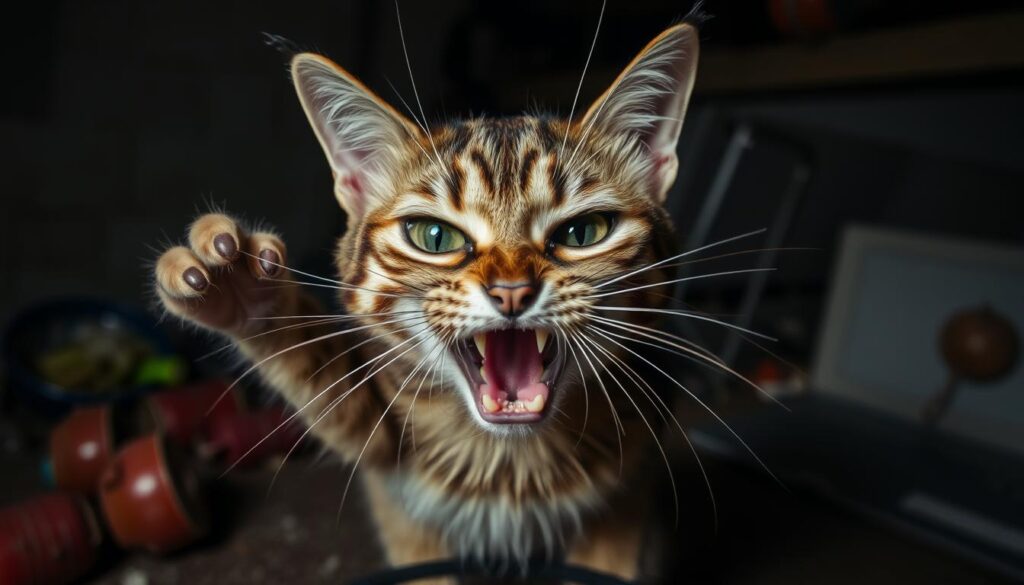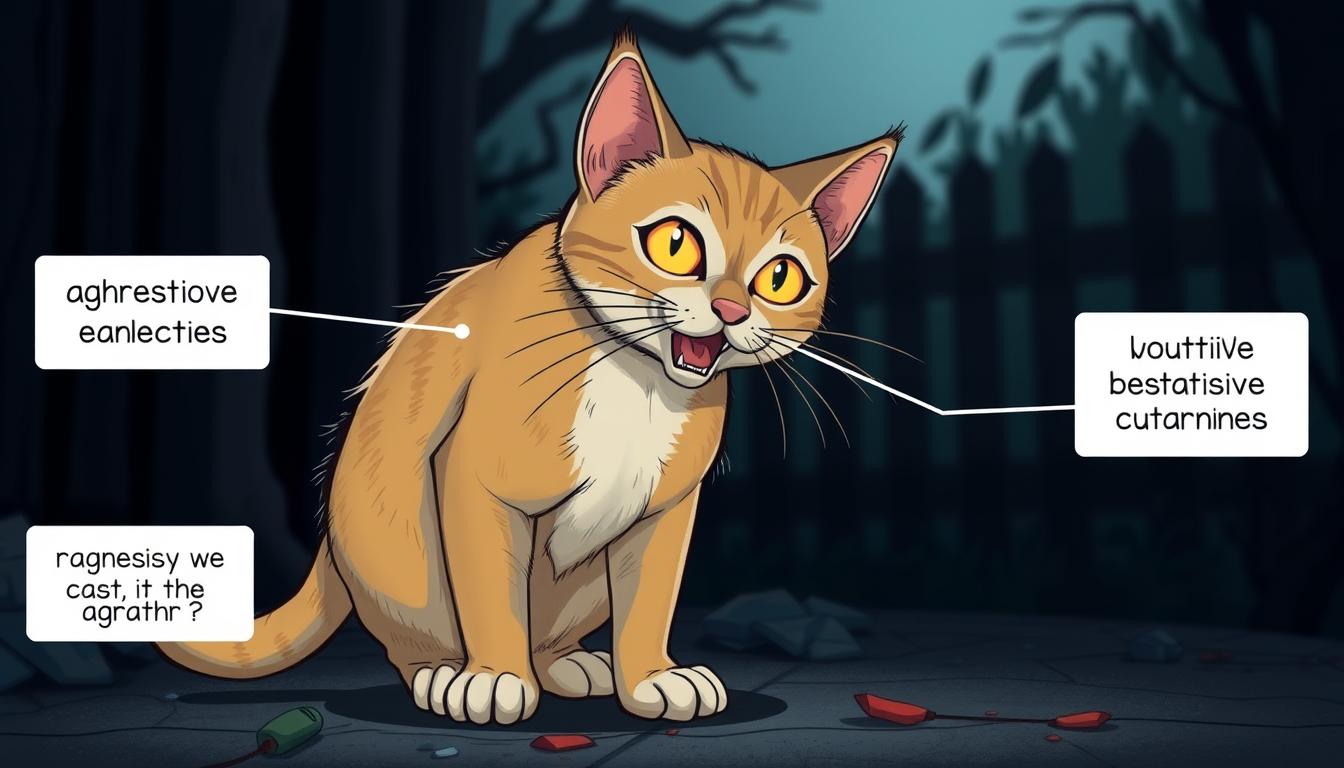Rabies is a serious viral disease that affects mammals, including cats. It’s a fatal condition that causes thousands of deaths every year. Sadly, 40% of these deaths are children under 15.
Rabies is preventable if treated quickly after exposure. As a cat owner, knowing the early signs is key. Look out for signs like lack of coordination, irritability, and nervousness. These can lead to paralysis and death.
Rabies can spread from animals to humans through bites or contact with infected saliva. It’s a zoonotic disease, making it a public health concern.
Knowing the signs of rabies in cats is crucial for their safety and yours. In this article, we’ll cover symptoms, how it progresses, and prevention. This will help you protect your cat and keep everyone safe.
Table of Contents
Understanding Rabies in Cats: A Deadly Viral Disease
Rabies is a deadly virus that affects cats and other mammals, including humans. It’s caused by the rabies virus, part of the Rhabdoviridae family. This virus attacks the nervous system, leading to severe damage and death if not treated.
How Rabies Affects the Feline Nervous System
When a cat gets bitten or scratched by an infected animal, the virus starts to multiply. It travels to the brain and spinal cord, causing damage. Eventually, it reaches the salivary glands, allowing it to spread to others through saliva.
The Zoonotic Nature of Rabies
Rabies can spread from animals to humans, posing a big health risk. If a cat or other animal bites you, you could get rabies. Quick medical care and treatment are key to prevent the disease.
Transmission Methods in Cats
Cats usually get rabies from wild animals like raccoons, bats, and foxes. The virus spreads through bites, scratches, or contact with infected saliva. Even indoor cats can get it if wild animals enter their home.
Signs of Rabies in Cats: Early Warning Indicators
It’s important to spot the early signs of rabies in cats to act fast and stop the disease from spreading. The first symptoms might be small, but they can help you know if your cat is getting sick.
One early sign is a drop in appetite. Cats with rabies might not want to eat, showing the virus’s effect on their nervous system. They might also get upset or startle easily, reacting more to their surroundings.
As rabies gets worse, cats may have trouble moving or staying balanced. This is because the virus is messing with their motor skills and brain. Rabies can take 2-3 months to show up, but it can start sooner or later.
In the beginning, cats might have a fever, pain, or feel strange sensations at the bite site. These symptoms can look like other illnesses, making it key to see a vet right away if you think your cat was bitten by a rabid animal.
Spotting these signs early helps protect your cat, your family, and the community from rabies. Quick vet visits and keeping up with vaccinations are key to keeping your cat safe and healthy.
“Rabies is a critical concern following animal bites, with animal control offices indicating that around 60,000 people annually receive rabies shots as a preventative measure after animal encounters.”
| Early Signs of Rabies in Cats | Incubation Period | Initial Symptoms |
|---|---|---|
| 2-3 months (can vary from 1 week to 1 year) |
|
The Progressive Stages of Feline Rabies
Feline rabies is a serious and often deadly disease. It goes through different stages. Knowing these stages helps catch the disease early and get help fast. We’ll look at the three main stages: the prodromal, furious rabies, and paralytic phases.
Prodromal Phase Symptoms
The prodromal phase of stages of rabies in cats lasts 2 to 10 days. Cats may feel like they have the flu, with fever, tiredness, and no appetite. They might also feel nerve damage, like tingling or numbness at the bite wound.
Furious Rabies Phase
The furious rabies cats phase lasts a few days to a week. Cats act very active, excited, and may see things that aren’t there. They can become very aggressive, want to wander a lot, and be very sensitive to sounds and touch.
Paralytic Phase Signs
The paralytic phase is the last stage, making up about 20% of paralytic rabies felines cases. Cats start to lose muscle control, starting at the bite wound and spreading. This stage can last up to a month and is often mistaken for other diseases.
The way rabies progresses in cats can vary. Symptoms can be different for each cat. Getting a vet right away is key, as once symptoms show, the disease is almost always fatal.
“Rabies has an almost 100% mortality rate once clinical signs appear. Early detection and immediate veterinary care are essential for the survival of any rabid cat.”
Behavioral Changes in Rabid Cats
Rabid cats can change a lot, showing sudden and big changes in how they act. These rabid cat behaviors are important signs for owners and vets to watch for.
One big change is when they become more aggressive. Usually, they are calm and loving, but they can suddenly get very angry. They might attack their owners or other animals. This change is scary and can be dangerous for people nearby.
Rabid cats may also seem restless, irritable, and confused. They might wander around without reason or hide for no good reason. As the disease gets worse, they might start to fear water or air. This makes their behavior even more unpredictable and scary.
These behavioral changes are key to catching rabies early. Spotting these signs can help get the cat to the vet fast. This can stop the disease from spreading and keep people safe.
“Rabies is a devastating disease that can rapidly transform a beloved pet into an unpredictable and dangerous animal. Vigilance and early detection of behavioral changes are essential in safeguarding both animal and human health.”
Knowing what rabid cat behavior looks like helps owners and vets act fast. They can keep the cat away from others, get it medical help, and stop the virus from spreading.

Physical Symptoms and Clinical Signs
The rabies virus attacks a cat’s nervous system, causing many symptoms. Cats may start meowing or howling more than usual. They might also have trouble moving, have seizures, or become paralyzed.
Watching a rabid cat get worse is very sad. They may drool a lot, have trouble swallowing, and their muscles might spasm. They might also be very sensitive to light and sound. As the disease gets worse, they can get very dehydrated, lose weight, and look very sick.
Neurological Manifestations
One key sign of rabies in cats is neurological problems. They might stumble, have trouble walking, or have seizures. In some cases, they can even become paralyzed, making it hard for them to move.
Physical Deterioration Signs
As the disease gets worse, the cat’s body will quickly get worse too. They might drool a lot, have trouble swallowing, and their muscles might spasm. They might also be very sensitive to light and sound, making them even more uncomfortable.
The cat’s body will quickly get worse. They might get very dehydrated, lose weight, and look very sick. These symptoms usually get worse fast, leading to the cat’s death in just a few days.
| Physical Symptoms | Neurological Symptoms |
|---|---|
|
|
The fast and severe symptoms of rabies in cats show how important it is to catch it early. Quick vet care and keeping up with vaccinations are key to stopping this deadly disease.
Risk Factors and Exposure Prevention
Rabies is a deadly virus that can affect both pets and wild animals. As a cat owner, it’s vital to know the risks and take steps to keep your cat safe. This will help prevent them from getting this serious illness.
Outdoor access is a big risk for rabies in cats. Cats that go outside are more likely to meet wild animals like bats or raccoons. These animals can spread the virus through bites. Keeping your cat inside is the best way to lower this risk and prevent rabies exposure.
Also, make sure your cat is current on their rabies vaccination. Vaccination protects your pet and helps stop the disease from spreading. It’s not just a suggestion; in many places, it’s the law.
- Avoid contact with wild animals, even if they seem friendly or approachable.
- Watch your cat when they’re outside and keep them on a leash or in a safe area.
- Teach your family, especially kids, not to touch or pet stray animals.
- Keep up with local rabies outbreaks and take the right steps to stay safe.
While rabies prevention in cats is key, it’s also important for public health. Most human rabies cases come from dogs, not cats. So, vaccinating dogs and being a responsible pet owner is crucial for everyone’s safety.
By staying informed and taking action to reduce rabies risk for felines, you can protect your cat. You’ll also help keep your community safe and healthy.

“Rabies is a 100% preventable disease, yet it remains a significant public health concern. Vaccination and responsible pet ownership are key to keeping our feline friends and communities safe.”
Diagnosis and Veterinary Assessment
Diagnosing rabies in cats is tough for vets. They look at symptoms and the cat’s history to guess if it has rabies. But, they really need to check the brain after the cat dies to be sure.
Laboratory Testing Methods
There are two main tests for rabies: immunofluorescence microscopy and PCR analysis. These tests check brain samples for the rabies virus. The LN34 PCR test is the best, according to the WHO and WOAH, because it’s very accurate.
Post-Mortem Confirmation
In the U.S., rabies test results come back in 24 to 72 hours after an animal is put down. These tests are sent to state health departments and the CDC. This helps track rabies and keep people safe.
Vets and pet owners must tell health officials if they think a cat has rabies. This helps stop the disease from spreading.
Treatment Options and Prognosis
Dealing with rabies in cats is tough. Once a cat shows symptoms, there’s no cure. Sadly, rabies is almost always fatal for cats at this point.
But, there’s hope if a vaccinated cat gets rabies. A booster vaccine might stop the disease before it starts. For unvaccinated cats, the usual action is euthanasia to stop their suffering and protect others.
For cats with rabies prognosis symptoms, care focuses on comfort. Vets try to ease the cat’s pain but can’t change the outcome. The cat will eventually die from the virus.
For people who get bitten, quick action is key. This includes washing the wound, getting rabies shots, and sometimes rabies immunoglobulin to help fight the virus.
“Rabies, once manifested, is nearly always fatal, leading to death within a few days.”
In short, cats with rabies have a very bad outlook. Prevention through vaccines is key. For those who get sick, care focuses on comfort and keeping others safe. Being careful and proactive is the best way to fight rabies.
Vaccination and Prevention Strategies
Vaccination is key to keeping your cats safe from rabies. Kittens get their first shot at 16 weeks, then another a year later. After that, they need shots every 1-3 years, based on the vaccine.
It’s also important for people at risk, like vets and animal handlers, to get pre-exposure shots. If you think you’ve been exposed to rabies, getting post-exposure shots is crucial.
Using human rabies vaccines under the skin is better than in the muscle. It’s cheaper and easier for patients, without losing safety or effectiveness. This is especially helpful where rabies is common and money is tight.
| Vaccination Recommendation | Details |
|---|---|
| Kittens | First rabies vaccine at 16 weeks, followed by a booster one year later |
| Subsequent Vaccinations | Every 1-3 years, depending on vaccine type |
| Pre-Exposure Prophylaxis | Recommended for high-risk occupations |
| Post-Exposure Prophylaxis | Crucial for potential rabies exposure |
| Vaccine Administration | Intradermal preferred over intramuscular for cost-effectiveness |
By keeping up with rabies vaccination for your cats, you can stop rabies in its tracks. This protects your family from a deadly virus.
Legal Requirements and Public Health Concerns
Feline rabies is a big deal for laws and public health. Many countries, like the UK, have strict rules to stop this deadly disease. These rabies laws for cats help keep animals and people safe. They make sure pets are well cared for and lower the risk of feline rabies public health problems.
In the UK, there are laws to keep rabies out. The Rabies (Importation of Dogs, Cats and Other Mammals) Order 1974 stops rabies-susceptible animals from coming in. The Non-Commercial Movement of Pet Animals Order 2011 and the Trade in Animals and Related Products Regulations 2011 also have rules. These include needing a pet passport for pets.
Rabies costs a lot worldwide, about US$ 8.6 billion each year. The World Health Organization (WHO) wants to stop human deaths from dog rabies by 2030. They say we need a One Health plan to fight the disease at its source.
| Legal Requirement | Description |
|---|---|
| Rabies (Importation of Dogs, Cats and Other Mammals) Order 1974 | Prohibits the entry of rabies-susceptible animals, like cats, into Great Britain without an import license. |
| Non-Commercial Movement of Pet Animals Order 2011 | Exempts pet dogs, cats, and ferrets from certain restrictions if rules are followed. |
| Trade in Animals and Related Products Regulations 2011 | Regulates commercial movements of dogs, cats, or ferrets and movements of more than five pets. |
Knowing the rabies laws for cats and feline rabies public health issues is key. Pet owners and everyone can help stop this disease. This keeps animals and people safe and healthy.
Conclusion
Rabies in cats is a big threat to animals and people. We need to spot symptoms early, get vet care fast, and keep up with shots. It’s also key to spread the word, take care of pets, and work together between vets and health teams.
Knowing the signs of rabies awareness cats and taking steps to prevent it is crucial. This way, we can aim to stop rabies from causing human deaths by 2030.
The feline rabies prevention importance is huge. In the U.S., cats are now more likely to get rabies than dogs. Unvaccinated cats can spread the virus, and even indoor cats can get exposed. So, it’s vital for pet owners to keep their cats up to date on shots and provide a safe, fun indoor space.
To beat rabies, we need a big effort from everyone. Vets, health officials, and pet owners must join forces. We must raise awareness, start vaccination programs, and handle any exposure quickly. By being careful and taking action, we can keep our cats safe and protect our communities from rabies.

